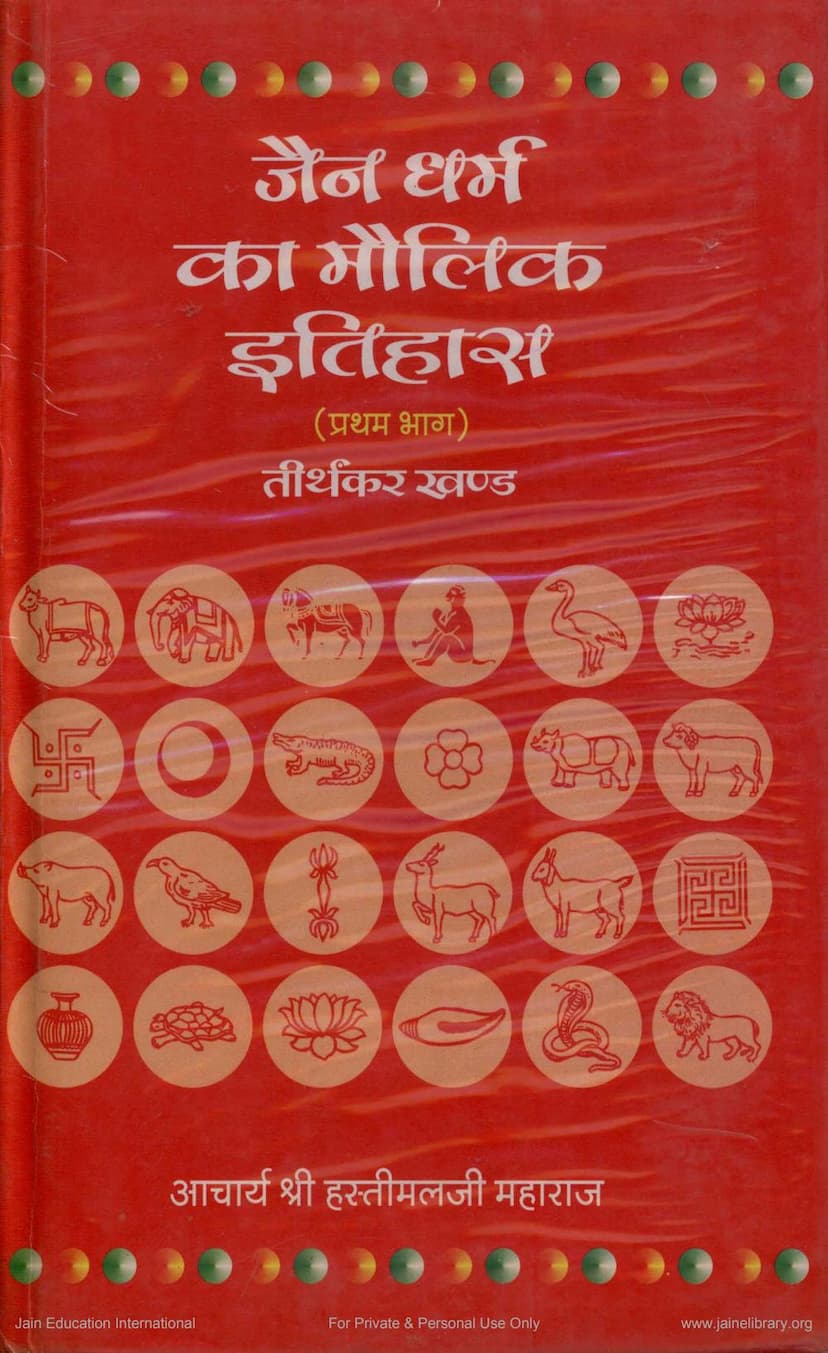Jain Dharma Ka Maulik Itihas Part 1
Added to library: September 2, 2025

Summary
Here's a comprehensive summary of "Jain Dharma ka Maulik Itihas Part 1" by Acharya Hastimal Maharaj, based on the provided text:
Overall Goal and Scope:
The book, "Jain Dharma ka Maulik Itihas Part 1 (Tirthankar Khand)," authored by Acharya Hastimal Maharaj and published by Jain Itihas Samiti Jaipur, aims to present a thorough and research-based history of Jainism, specifically focusing on the lives and eras of the Tirthankaras. It seeks to provide new insights and a deeper understanding of key figures and events from Lord Rishabhdev to Lord Mahavir.
Key Features and New Contributions:
The book highlights several unique aspects:
- Comprehensive Era Depiction: It offers a detailed exploration of the period from Lord Rishabhdev to Lord Mahavir.
- Lord Rishabhdev's Role: A fascinating analysis of Lord Rishabhdev as the progenitor of human civilization.
- Lord Arishtanemi's Era: Presents new research-based findings concerning Lord Arishtanemi and his time.
- Lord Parshvanath's Significance: Explains the divine nature of Lord Parshvanath and provides insights into contemporary religious traditions.
- Lord Mahavir's Impact: A broad examination of Lord Mahavir's life, practices, influence, and the associated era, including the latest authenticated perspectives on the chronology of his life and that of Goshala.
Methodology and Sources:
Acharya Hastimal Maharaj and the History Committee employed a rigorous approach:
- Extensive Research: The author, guided by extensive knowledge of Jain Agamas, Sanskrit, and history, undertook extensive research.
- Travel and Study: Acharya Maharaj traveled extensively through Gujarat and Rajasthan, visiting ancient libraries and manuscript collections to gather historical material from thousands of ancient texts.
- Scholarly Collaboration: The project involved consultation with prominent Jain scholars like Justice Indranath Modi, Shri DalSukhbhai Malvania, and Dr. Narendra Bhanawat.
- Compilation and Analysis: The collected material was meticulously analyzed, cross-referenced, and organized chronologically and sequentially.
- Linguistic Accessibility: While acknowledging the richness of ancient Jain literature in Sanskrit, Prakrit, and Apabhramsha, the book aims to present this historical knowledge in an accessible manner.
Structure and Content (Tirthankar Khand):
The first volume, dedicated to the Tirthankaras, covers the following:
- Introduction to Time Cycles: Explains the concept of Kalachakra and Kulakaras (civilization founders).
- Detailed Biographies of Tirthankaras: The core of the book is dedicated to the individual Tirthankaras, providing information on:
- Their previous lives and the means of attaining Tirthankarhood.
- Birth, naming ceremonies, royal coronations, renunciations, periods of asceticism, attainment of Kevalgyan (omniscience), their preachings, their four-fold monastic assembly (monks, nuns, laymen, laywomen), and their nirvana.
- Specific details are provided for each of the 24 Tirthankaras, starting from Lord Rishabhdev and concluding with Lord Mahavir.
- The book meticulously details the lives of Lord Rishabhdev, Lord Ajitnath, Lord Sambhavanath, Lord Abhinandanath, Lord Sumatinath, Lord Padmaprabh, Lord Suparshvanath, Lord Chandraprabh, Lord Puspadanta (Suvidhinath), Lord Sheetalnath, Lord Shreyanshnath, Lord Vasupujya, Lord Vimalnath, Lord Anantnath, Lord Dharmanath, Lord Shantinath, Lord Kunthunath, Lord Aranath, Lord Mallinath, Lord Munisuvrat, Lord Naminath, Lord Arishtanemi, Lord Parshvanath, and Lord Mahavir.
- Key Historical Figures: It also discusses prominent figures associated with the Tirthankaras, such as Chakravartis (Bharat, Sagar, Magdha, etc.), Baldevs, Vasudevs (Krishna), and Pratitvasudevs (Jarasandha).
- Special Topics:
- The lineage and origins of the Harivansh.
- The fascinating discourse on King Upriachara Vasu.
- A detailed account of King Vasudeva's personality.
- An analysis of the political landscape of the time.
- Arishtanemi's valor and the philosophical mysteries he unveiled.
- The significance of the sage Gajasukumal.
- The historical context of Lord Parshvanath and his profound influence.
- The impact of Lord Parshvanath's teachings on Buddha.
- The influence of Lord Parshvanath on the royal class.
- The Tirthankaras' teachings and their unique characteristics, including their 34 extraordinary powers (atishayas) and 35 qualities of their speech.
- A comparative study of Shvetambara and Digambara traditions regarding Tirthankaras.
- The historical timing of Lord Mahavir and Lord Buddha.
Philosophy and Principles Emphasized:
- History as a Guide: The book views history as a scientific tool for understanding the past, providing guidance for future generations, and highlighting the rise and fall of civilizations, cultures, and individuals.
- Importance of Dharma: It underscores the paramount importance of Dharma (righteousness, duty, spiritual path) for the well-being of individuals, societies, and nations.
- Tirthankaras as Exemplars: The Tirthankaras are presented as ideal spiritual leaders and law-givers who awakened humanity's inner potential and guided them towards self-realization and collective welfare.
- Self-Reliance in Sadhana: Even though Tirthankaras are revered by divine beings, their own rigorous self-discipline, penance, and independent spiritual effort are highlighted.
- Karma and Rebirth: The concept of karma and its influence on one's life, including the Tirthankaras' previous lives and the formation of Tirthankar-hood, is central.
- Nishchaya and Vyavahara: The text navigates the distinction between ultimate reality (Nishchaya) and conventional reality (Vyavahara), showing how Tirthankaras embodied both.
- Caste and Lineage: The book addresses the question of why Tirthankaras were born in Kshatriya lineage, explaining it in terms of the need for outward strength and leadership qualities to propagate Dharma effectively, rather than birth-based superiority.
Challenges and Contributions to Jain History:
The book acknowledges the difficulty in reconstructing Jain history, especially the period after Devarshi Gani Kshamashraman, which was often considered obscure. Acharya Hastimal Maharaj's work is seen as a monumental effort to fill this void, making the history of the Tirthankara period exceptionally clear and comprehensive. The publication of this work is considered a significant contribution to filling a long-standing gap in Jain historical literature.
Overall Impact:
"Jain Dharma ka Maulik Itihas Part 1" is a scholarly and comprehensive work that aims to illuminate the history of Jainism through the lens of its Tirthankaras. It is presented as a vital resource for understanding the origins, development, and core principles of Jain Dharma, offering new perspectives and shedding light on previously obscure periods and aspects of this ancient tradition.